Related Research Articles
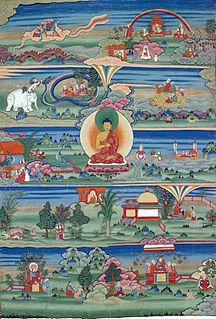
The Jātaka tales are a voluminous body of literature native to India concerning the previous births of Gautama Buddha in both human and animal form. The future Buddha may appear as a king, an outcast, a god, an elephant—but, in whatever form, he exhibits some virtue that the tale thereby inculcates. Often, Jātaka tales include an extensive cast of characters who interact and get into various kinds of trouble - whereupon the Buddha character intervenes to resolve all the problems and bring about a happy ending.

Sarnath is a place located 10 kilometres north-east of Varanasi near the confluence of the Ganges and the Varuna rivers in Uttar Pradesh, India. The deer park in Sarnath is where Gautama Buddha first taught the Dharma, and where the Buddhist Sangha came into existence through the enlightenment of Kondanna.
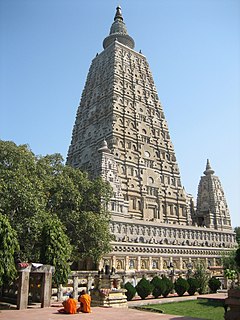
The Mahabodhi Temple, a UNESCO World Heritage Site, is an ancient, but much rebuilt and restored, Buddhist temple in Bodh Gaya, marking the location where the Buddha is said to have attained enlightenment. Bodh Gaya is about 96 km (60 mi) from Patna, Bihar state, India.

Taxila is an important archaeological site of the ancient Indian subcontinent, located in the city of Taxila in Punjab, Pakistan. It lies about 32 km (20 mi) north-west of Islamabad and Rawalpindi, just off the famous Grand Trunk Road.
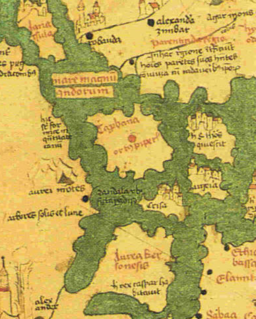
Suvarṇabhūmi is a toponym, that appears in many ancient Indian literary sources and Buddhist texts such as the Mahavamsa, some stories of the Jataka tales, the Milinda Panha and the Ramayana.

The Kizil Caves are a set of Buddhist rock-cut caves located near Kizil Township in Baicheng County, Xinjiang, China. The site is located on the northern bank of the Muzat River 65 kilometres west of Kucha. This area was a commercial hub of the Silk Road. The caves are said to be the earliest major Buddhist cave complex in China, with development occurring between the 3rd and 8th centuries.

Avadāna is the name given to a type of Buddhist literature correlating past lives' virtuous deeds to subsequent lives' events.

The Mahājanapadas were sixteen kingdoms or oligarchic republics that existed in ancient India from the sixth to fourth centuries BCE. Two of them were most probably ganatantras (republics) and others had forms of monarchy. Ancient Buddhist texts like the Anguttara Nikaya make frequent reference to sixteen great kingdoms and republics which had evolved and flourished in a belt stretching from Gandhara in the northwest to Anga in the eastern part of the Indian subcontinent and included parts of the trans-Vindhyan region, prior to the rise of Buddhism in India.

In Hindu mythology, a kinnara is a paradigmatic lover, a celestial musician, half-human and half-horse (India). In South-east Asia, two of the most beloved mythological characters are the benevolent half-human, half-bird creatures known as the Kinnara and Kinnari, which are believed to come from the Himalayas and often watch over the well-being of humans in times of trouble or danger. Their character is clarified in the Adi parva of the Mahabharata, where they say:
Shivi is mentioned as a kingdom and as the name of a king in the ancient Indian epic Mahabharata. There was a king named Shivi who became famous as Shivi or the kingdom itself may be named after him. Shivi king was famous for his truthfulness. The legend about his truthfulness and compassion goes as follows: King Shivi protected a dove who was chased by a hawk, and gave flesh from his thigh, as a substitute meal to the hawk.
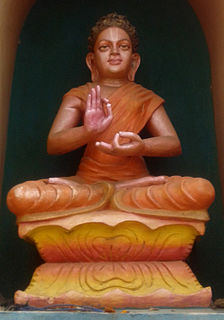
In Vaishnava Hinduism, the historic Buddha or Gautama Buddha, is considered to be an avatar of the Hindu god Vishnu. Of the ten major avatars of Vishnu, Vaishnavites believe Gautama Buddha to be the ninth and most recent incarnation.

The Ananda Temple, located in Bagan, Myanmar is a Buddhist temple built in 1105 AD during the reign (1084–1113) of King Kyanzittha of the Pagan Dynasty. It is one of four surviving temples in Bagan. The temple layout is in a cruciform with several terraces leading to a small pagoda at the top covered by an umbrella known as hti, which is the name of the umbrella or top ornament found in almost all pagodas in Myanmar. The Buddhist temple houses four standing Buddhas, each one facing the cardinal direction of East, North, West and South. The temple is said to be an architectural wonder in a fusion of Mon and adopted Indian style of architecture. The impressive temple has also been titled the "Westminster Abbey of Burma". The temple has close similarity to the Pathothamya temple of the 10th–11th century, and is also known as “veritable museum of stones”.

Sankassa was an ancient city in India. The city came into prominence at the time of Gautama Buddha. According to a Buddhist source, it was thirty leagues from Savatthi. After the Gautama Buddha's Mahaparinirvana king Ashoka developed this place and installed one of his famous Pillars of Ashoka in the city, from which the elephant capital survives. He also built a stupa and a temple commemorating the visit of the Buddha. This temple exist even today and the ruins of the stupa are also present as a temple of Vishari Devi. It is said that the name Visahari Devi is given to the mother of the Buddha.

The Licchavis were a clan amongst the Vajji Mahajanapada of ancient India. Vaishali the capital and homeland of the Licchavis, was the capital of the Vajji mahajanapada also. It was later occupied by Ajatashatru, who annexed the Vajji territory into his kingdom.

The Mahāvastu is a text of the Lokottaravāda school of Early Buddhism. It describes itself as being a historical preface to the Buddhist monastic codes (vinaya). Over half of the text is composed of Jātaka and Avadāna tales, accounts of the earlier lives of the Buddha and other bodhisattvas.
Mahākapphina (Pali) or Mahākapphiṇa (Sanskrit), also called Mahā Kapphina Thera, was an eminent Arhat from Uttarapatha and is considered foremost among those who taught the monks. Mahākapphina was his monastic name. He became disciple of the Buddha and is one of the five hundred Arhats who will be reborn and attain Buddhahood, according to Mahāyāna tradition. References to Kapphina can be found in the Jātakas, Buddhaghoṣa's Manorathapūranī, the Dhammapada Aṭṭhakathā, the Visuddhimagga, the Sāratthappakāsinī, the Saṃyutta Nikāya, the Aṅguttara Nikāya, the Vinaya Piṭaka, the Theragāthā, etc.; as well as in the Sanskrit Avadānaśatika.
The four harmonious animals, four harmonious friends or four harmonious brothers Standard Tibetan: མཐུན་པ་སྤུན་བཞི། (Wylie: mthun pa spun bzhi or Wylie: mthun pa rnam bzhi ) is a figure in Jātaka tales and other Buddhist mythology, and can often be found as subject in Bhutanese and Tibetan art. It is perhaps the most common theme in Bhutanese folk art, featuring on many temple murals, stupas, and as a decorative pattern on many daily utensils. It is the best-known national folktale of Bhutan and is popular in Tibet and Mongolia: it is widely referred to in these cultures.

The Vessantara Jātaka is one of the most popular apadānas of Theravada Buddhism. The Vessantara Jātaka tells the story of one of Gautama Buddha's past lives, about a compassionate prince, Vessantara, who gives away everything he owns, including his children, thereby displaying the virtue of perfect generosity. It is also known as the Great Birth Sermon. The story has slight variations in other parts of Asia where the story is known as the Jinaputra Arthasiddhi sutra in Tibet and the prince known as "Prince Arthasiddhi" and in China it's known as Taizi Xudanuo jing where the prince is known as "Prince Sudana" (須大拏太子) and "Shudaina-taishi" in Japan.
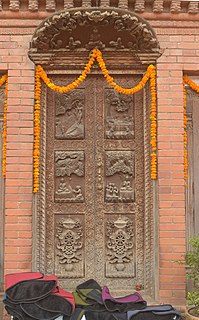
The Buddhist traditions have created and maintained a vast body of mythological literature. The central myth of Buddhism is the life of the Buddha. This is told in relatively realistic terms in the earliest texts, and was soon elaborated into a complex literary mythology. The chief motif of this story, and the most distinctive feature of Buddhist myth, is the Buddha's renunciation: leaving his home and family for a spiritual quest. Alongside this central myth, the traditions contain large numbers of smaller stories, which are usually supposed to convey an ethical or Buddhist teaching. These include the popular Jātakas, folk tales or legends believed to be past lives of Gautama Buddha. Since these are regarded as episodes in the life of the Buddha, they are treated here as “myth”, rather than distinguishing between myth, legend, and folk-tale.
Kalinga II was a powerful monarch and possibly an emperor from around the speculated era towards the end of 7th century BCE. He was the son of Chullakalinga, the youngest son of Kalinga I who had married a virtuous princess from Sagala (Madra). Kalinga II ascended the throne of the ancient state of Kalinga after the death of his paternal uncle Mahakalinga. Kalinga II finds mention in early Buddhist Jataka records of Chullakalinga Jataka and Kalingabodhi Jataka. He had spent most of his young life in the forests of Himavat where his father lived in exile. Trained with qualities of a king by his father and maternal grandfather, he was asked by Chullakalinga to go back to take the charge of his ancestral kingdom.